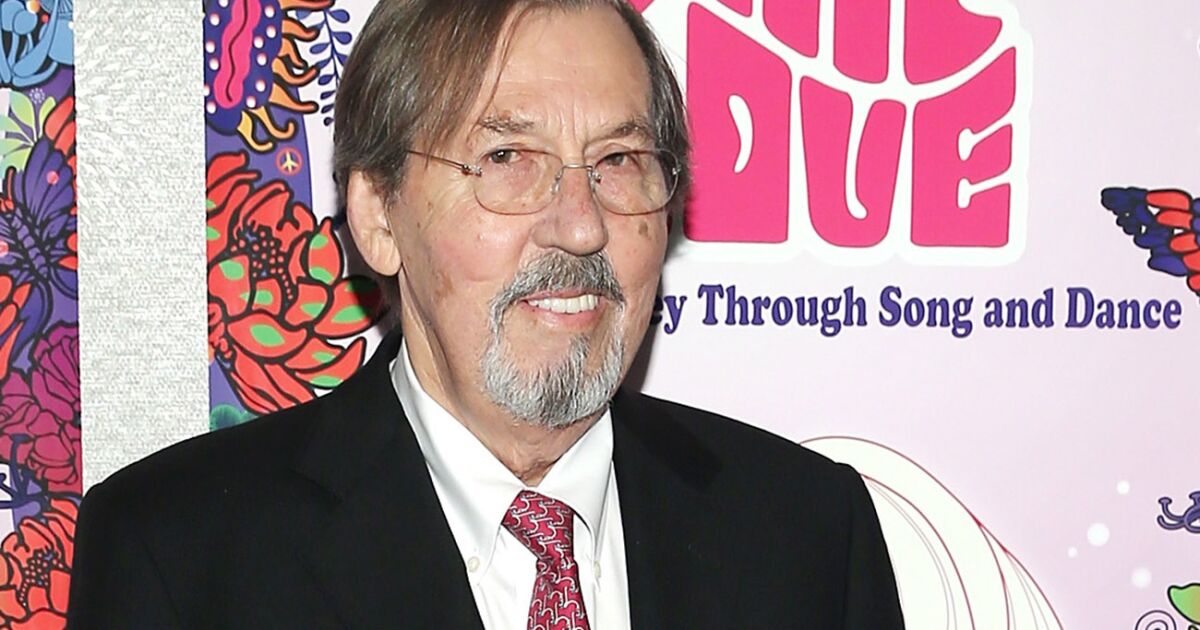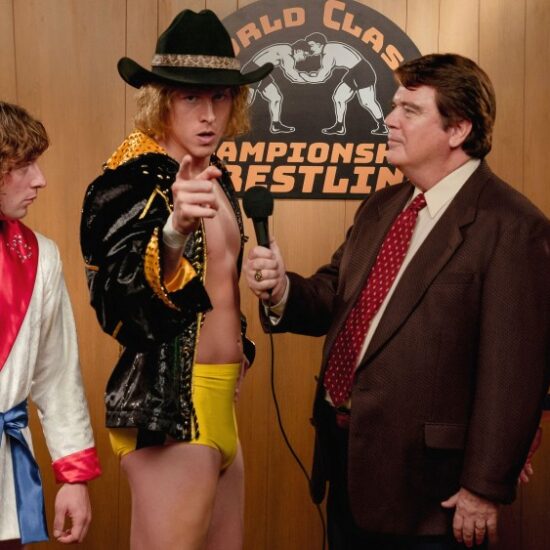
Robin Wagner, the legendary Broadway set designer who created the stage worlds of “The Producers,” “Angels in America,” “Crazy for You”, “Hair,” “Dreamgirls” and dozens more, framed “ A Chorus Line” in black velour and mirrors, and once plopped Mick Jagger in the center of a chromium lotus for the Stones’ 1975 Tour of the Americas, has died at his Manhattan home.
Wagner, who died in his sleep May 29, was 89.
His theatrical output was staggering. Between 1961 and 2012, he designed 63 Broadway plays and musicals, according to his daughter Christie Wagner Lee, garnering Tony Awards for the original Broadway productions of “The Producers,” “On the Twentieth Century” and “City of Angels.” Another seven of his shows brought him Tony nominations.
The versatility of his work was similarly impressive. For Larry Gelbart’s “City of Angels,” a musical comedy thriller about private eyes, moviemaking and Hollywood romance, he came up with 46 scene changes — one every three or four minutes. “A Chorus Line’s” set was so minimal, he liked to say, that once you added the white line on the floor, “that’s all you needed to do the show. You could do it in a parking lot.”
“Go back to Shakespeare,” Wagner would often say. “In the first seven lines of ‘Hamlet,’ you learn everything you need to know — the place, time, weather, situation and all the characters’ names. I start with the principle that everything has to earn its place on the stage. If it doesn’t have to be there, you get rid of it.”
“Robin Wagner was a true artist and an artist who found himself in the most collaborative of art forms — musical theater,” said the Tony-winning director and choreographer Susan Stroman, a frequent collaborator. “I was lucky to have worked with Robin many times as both a director and choreographer on shows including ‘Crazy for You’ and ‘The Producers.’ He was a master at designing sets that moved and constantly pushed the plot forward. He had the soul of a dancer, fitting for the man who designed “A Chorus Line.”
Wagner also designed ballet sets, including one for Stroman’s ballet “Double Feature” at the New York City Ballet. His opera sets graced stages at the Metropolitan Opera, Swedish Royal Opera, Hamburg State Opera, Vienna State Opera and the Royal Opera at Covent Garden.
Tall and dapper, Wagner usually dressed as if he were going to work in an office, not the theater. His nicely polished shoes crunched wood shavings where sets were being assembled, and his sports jacket and tie were in sharp contrast to the jeans most of his colleagues were wearing.
But Wagner thought like an artist. “When I’m reading the script, I can see how it all fits together and how you get from one scene to another,” he said at one point. “I guess that’s what makes designers designers — they visualize things a certain way. Writers see words and paragraphs — we see little pictures.”
Robin Wagner was born Aug. 31, 1933, in San Francisco. His father was a lighthouse keeper, his mother a concert pianist from New Zealand, and he recalled attending 25 schools in both the United States and New Zealand during his youth. He went to movies as a child, he said, but not plays. As a teenager trying to impress his ballerina girlfriend, he once volunteered to paint toe shoes on the window of her teacher’s studio, found out he could actually draw, and went off to art school.
He never formally studied theater design. “I went to art school and studied sketching, started buying books about theater and sneaking backstage,” said Wagner. “But I never got formal design training. I was taught by directors.”
He left San Francisco for New York with a friend in 1957. “We arrived at the old 34th Street Terminal around 5 a.m.,” he once told a theater audience, “and the one place we wanted to go was to Broadway. So we ran to Times Square and grabbed some coffee so we could watch the sun rise in Shubert Alley. I had no idea if I would ever work in the theater in New York, but that was my street of dreams. And I still get excited when I walk across that alley.”
He soon started doing work off-Broadway. He worked on 27 off-Broadway shows, and said that when the regional theater movement began, it proved a great training ground. He managed to work for Oliver Smith, who had designed “Brigadoon” and the original “My Fair Lady,” the first Broadway show Wagner ever saw. He spent five years with Smith, and said he learned everything about musicals from him.
Wagner listened to his directors. The biggest problem for a set designer, Wagner told The Times, was “how you get into the director’s head and create the ship he has to steer. He’s the captain. You’re just the engineer throwing coal into the engine.”
Wagner often used a ship metaphor. He saw shows as ships with directors as captains and “the captain is always right. There has to be a single vision, If you can’t make his vision come to life, the show won’t work. It’s like a heartbeat.
“There are 1,000 moving parts. And just when you think you’re on top of it, some part blows out and you have to rebuild it. It’s like a bubbling soup and you try to dance on it. But you never know when it’s going to boil over. And everybody’s hungry.”
His three children have all worked in the arts. His daughter Christie, named after the central character in “The Playboy of the Western World,” the play he was working on when she was born, has been a director and producer and often worked with him. His son, Kurt, is an architectural lighting designer and his older daughter, Leslie, named after Leslie Howard, is a painter.
Asked why they all wound up in the arts at some point, Christie replied that “it was something he would get excited about, and backstage was a comfortable place to be. He took us to load-ins at the theaters, and we watched rehearsals. My first show was ‘Hair’ when I was 5. He took us to the shop to look at scenery and to painting studios. He didn’t have a studio yet when we were young, so we were always around.”
In the early to mid-’70s, his design studio was in the middle of the family’s apartment, recalled his second wife, film and theater producer Paula Wagner. “In retrospect, it was great that I got to see the evolution of his process. Brilliant is a word we use too liberally, but it applied to Robin in every way. He was equally adept with spectacle and simplicity, and he could have both extremes in one show. He virtually redefined what set design was.”
Later, Wagner worked in a sunny corner studio at 890 Broadway, a place where Broadway musicals have rehearsed for years. Old drawings were in drawers, blueprints were tacked up on the walls and models neatly assembled either on top of tables or on shelves below.
David Peterson, now resident scenic designer at the Metropolitan Opera, was Wagner’s studio assistant for 27 years, leaving in 2017 when Wagner closed the office. “Robin worked with the best in the business,” said Peterson. “Not just directors but choreographers, other designers, the shops. As a problem solver, he was unparalleled. He was so smart. He did the work, and like other top professionals, he made it look easy.”
Easy it wasn’t, said Neil Mazzella, CEO of Hudson Scenic Studio in Yonkers, which did 22 Broadway shows with Wagner. “Every time he did a show, he challenged himself and everyone else who was part of it. Not every challenge he gave us worked — the high gloss on ‘Saturday Night Fever’s’ dance floor and ceiling was a nightmare, for instance — but we did it anyway.”
Wagner was a fanatical researcher and reader. His bookshelves were filled with books on all sorts of subjects. And for a movie-oriented show like “City of Angels” he estimated he sat through 100 movies — some of them six or seven times — to soak up atmosphere.
Movies and books were just the beginning. Daughter Leslie said there were rocks all over the house that he collected on his research travels, often to exotic locales. Each was labeled where it was from, such as the rock he brought back from a research trip to Israel for “Jesus Christ Superstar.” He would often share his research slides, rocks and stories with his family.
For many years, Wagner also hosted a get-together he called the Bartender Bash where he would invite people from restaurants and bars he frequented to his apartment where he and his son, Kurt, would wait on them. “It was a great night,” recalled his longtime partner Susan Kowal. “He was a great storyteller. The people who worked with him were often in awe of him, but they all loved working with him.”
Wagner is survived by his partner, Susan Kowal and his children Kurt Wagner, Leslie Wagner and Christie Wagner Lee and a granddaughter, Clementine Lee.
Barbara Isenberg is the author of “Making It Big: The Diary of a Broadway Musical,” and a former Times staff writer.












